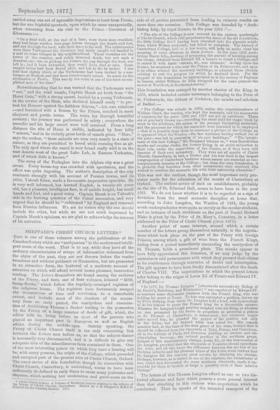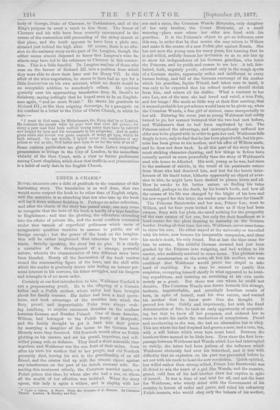SHEPPARD'S CHRIST CHURCH LETTERS.*
Tuts is one of those volumes among the publications of the Camden Society which are "antiquarian" in the modern and intelli- gent sense of the word. That is to say, while they have all the ordinary characteristics of scraps of information redeemed from the abyss of the past, they are not thrown before the reader broadcast and without guidance or illustration, but are presented in an attractive form, the bestowal of a moderate amount of attention on which will afford several hours pleasant, instructive reading. The Letters themselves are found among the archives of the Priory, and form one of four volumes, lettered "MSS. Scrap-Books," which follow the regularly-arranged registers of the religious house. The registers have fortunately escaped the devastations of time and revolution to a remarkable extent, and include most of the charters of the monas- tery from an early period, the martyrdom and canonisa- tion of Archbishop Thomas k Becket leading to the possession by the Priory of a large number of deeds of gift, which, the editor tells us, bring before us most of the persons who played an important part in European as well as English affairs during the middle-ages. Strictly speaking, the Priory of Christ Church itself is the only connecting link between the Letters now before us, so that the subject-if:latter is necessarily very disconnected, and it is difficult to give any adequate idea of the miscellaneous facts contained in them. One of the most interesting points on which they have a bearing will be, with many persons, the origin of the College, which preceded and occupied part of the present area of Christ Church, Oxford. The exact status of this foundation, though its connection with Christ Church, Canterbury, is undoubted, seems to have been sufficiently ill-defined in early times to cause many jealousies and disputes, which nothing but moderation and good-sense on the corn Chtirch LO .rs. A Volume of Alec-Ewald Lettere relating to the Anise of be Priory of Christ 'Church, Canterbury. Edited by J. B. Sheppard, M.E.C.S. Pointed for the Camden Society. 1877.
side of all parties prevented from leading to ruinous results on more than one occasion. This College was founded by " Arch- bishop Islip, by royal licence, in the year 162
" The site of the College is now covered by the eastern quadrangle of Christ Church, which still perpetuates the name of the old foundation, the little College itself having boon absorbed into the gigantic neigh- bour, which Wolsoy projected, but failed to complete. The history of Canterbury College, Lula in a few words, will help to make clear the meaning of sotno allusions in these Letters. In the year 1362 Arch- bishop Simon Islip, desirous of promoting the pursuit of learning among the clergy, obtained from Edward III. a licence to found a College, and to endow it with lands ' statute, ens., non obetante: Acting upon the licence, he acquired a site near the Priory of St. Frideswyde, and upon it he either erected the necessary buildings, or adapted those already existing to suit the purpose fur which he destined them. For the support of the foundation ho appropriated to it the rectory of Pagham in Sussex, whilst William de Islip assigned for the same purpose the manor of Woodford, in Northamptonshire."
This foundation was enlarged by another charter of the King, in 1373, which included certain messuages belonging to the Prior of St. Frideswyde, the Abbess of Godstow, the monks and scholars of Balliol :—
"The College was rebuilt in 1396, under the superintendence of William Chart, the warden who kept the accounts, and his statements of expenses for the years 1396 and 1397 are yet in existence. These are so precisely drawn up—recording the sums paid for wages week by week to the artificers, tho names of the persons furnishing materials, and the purposes for which the materials were intended to be employed —that it is possible from them to construct a picture of the College as it appeared when the Warden—the last workman having walked out of the gate—was loft in possession of his now buildings." "The inhabi- tants of this now College," Mr. Sheppard informs us, "were Benedictine monks and secular clerks, the former living in as strict subjection to their rule under the supervision of the ()tidos, as if they were still inmates Of their own monastery. They were not all monks of Christ Church, Canterbury, in fact, a C/ustos and his four Socii is the largest congregation of Canterbury brethren whose names are recorded as con- temporaneous inmates of the College ; but from the very foundation, it is probable that boarders from other monasteries were received, who wished to combine the monastic life with their university education."
This was not the earliest, though the most important early pro- vision made for the education of the monks of Canterbury at Oxford. The earliest notice of such an establishment, probably on the site of St. Edmund Hall, seems to have been in the year 1331.We do not know whether it is to be regarded as a sign of deviation from the usual monastic discipline at home that, according to John Langdon, the Warden of 1494, the young monk-undergraduates were quite as unruly as the secular students,
and an instance of such unruliness on the part of Daniel Richard Blake is given by the Prior of St. Mary's, Coventry, in a letter addressed to the Prior of Christ Church (circa 1474).
Another point of some interest, around which a certain number of the letters group themselves naturally, is the negotia- tions which took place on the part of the Priory with foreign Princes, among which a gift of wine from the French Kings, dating from a period immediately succeeding the martyrdom of St. Thomas, holds a prominent place. The monks appear to have fully appreciated this donation, if we may judge by the earnestness and perseverance with which they pressed their claims to its continuance through centuries of doubt and interruption. The gift appears to have been finally discontinued after the death of Charles VIII The negotiations to which the present letters refer belong to the reigns of Louis XL of France and Edward IV.
of England :—
"In 1477, Dr. Thomas Langton" [afterwards successively Bishop of St. David's, Salisbury, and Winehester] " was employed by Edward IV. to conduct some diplomatic business with the French king, who was holding his court at Tours. To him was entrusted a petition, drawn up by Prior Sollyng, from whom Dr. Langton held a brief, with instructions to do his utmost to press the French king for a favourable answer. position weighed with the King, or whether
Whether Dr. Langton's high
he was prompted by his desire to propitiate so powerful a patron as St. Thomas of Canterbury, is immaterial; but whatever might laaVo moved him, he granted the prayer of the petition not only to the letter, but far beyond what was asked for. His remote ancestor had, at the time of the first grant of the wine, &aided that it should be collected front the vineyards of Triol, Poissy, and Cantelourb all in the latitude of Paris, and therefore yielding an austere and un- stimulating beverage, the natural product of the northern grape. Instead of this unsatisfactory vintage, Louis EL, at the interoossion of Dr. Langton, provided that the vineyards of Touraino should contribute the wino, and all who know the difference between the via bleu of the Parisian suburbs and the pleasant wines of the Loire must confess that Dr. Langton did the convent good service by obtaining the change. Perhaps, however, as is hinted in one of the charters, the vicissitudes of war, which had devastated the more northern vineyards, made it im- possible for them to furnish so largo a quantity oven of their inferior
vintage." The letters of this Thomas Langton afford us one or two his- torical allusions and facts which possess a more general interest than that attaching to this curious wine-negotiation which he conducted. Thus he speaks of the intended transport of the body of George, Duke of Clarence, to Tewkesbury, and of the King's purpose to erect a tomb to him there, The bones of Clarence and his wife have been recently encountered in the course of the restoration still proceeding of the abbey church at that place, and the tomb appears to have been a plain one, situated just behind the high altar. Of course, there is no allu- sion to the malmsey story onthe part of Dr. Langton, though the editor seems almost disposed to fancy that Langton's wine in- stincts may have led to the reference to Clarence in this connec- tion. This is a little fanciful. Dr. Langton was:one of those who
rose on the favour of Richard III. into a position from which they were able to show their later zeal for Henry VII. In this affair of the wine-negotiation, he seems to have had an eye for a little honorarium on his own account, which no doubt would be
an acceptable addition to somebody's cellars. He rejoices quaintly over his approaching translation from St. David's to Salisbury, saying jestingly that he hoped soon to be an English-
man again, "and no more Welsh." He shows his gratitude to Richard III., as the then reigning Sovereign, by a panegyric on his conduct in a letter to the Prior of Christ Church, in which he says :— " I trust to God sune, by Miehelmasse, the liyng fibril be at London. He contents the people wher he goys beet that ever did prince; for many a poor man that bath suffred wrong many days have he relevyd and helpyd by hym and his commands in his progresso. And in many grate eiteis and townie wer greto summis of mony gif hym, which ho bath refusyd. On my troutb, I lykyd never the eondicions of ony prinee so wel as his; God bathe sont hym to us for tho well) of us al."
Some curious particulars are given in these Leticrs respecting
presentation to livings in the City of London, in the immediate vicinity of the then Court, with a view to future preferment
among Court chaplains, which show that traffic in iiczt presentations is a habit of early date in the English Church.



































 Previous page
Previous page